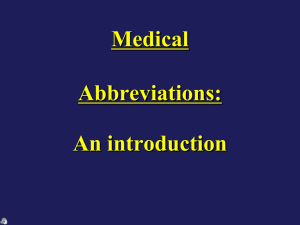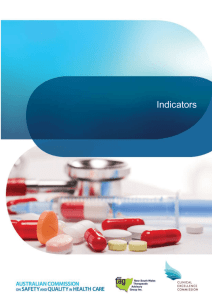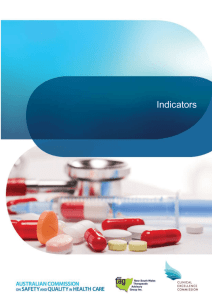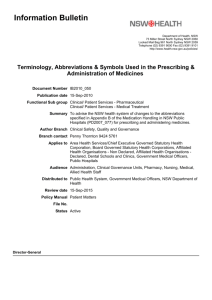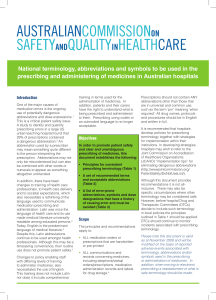WORD - Australian Commission on Safety and Quality in Health Care
advertisement
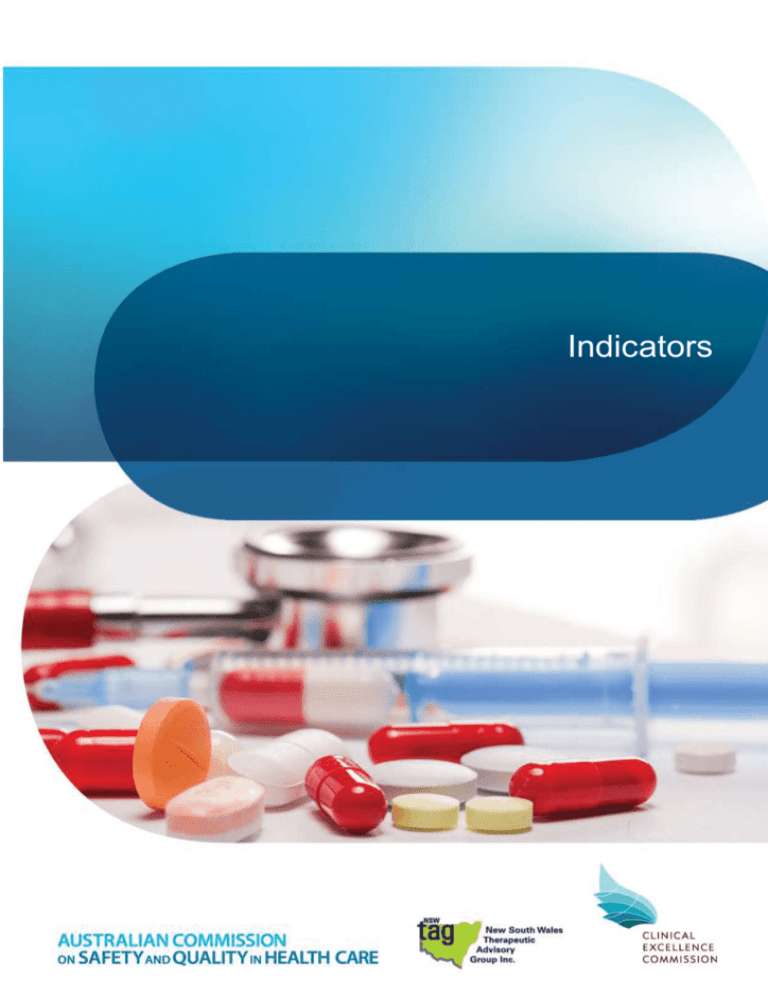
Indicators Medication ordering QUM domains: Safe and effective use 3.3 Percentage of medication orders that include errorprone abbreviations Purpose This indicator assesses the effectiveness of processes that encourage clear and unambiguous communication of medication orders. Background and evidence One of the major causes of medication errors is the use of potentially dangerous abbreviations in presc ribing. 1 An abbreviation used by a prescriber may mean something quite different to the person interpreting the prescription. Abbreviations may not only be misunderstood but can also be combined with other words or numerals to appear as something altogether unintended. Although using abbreviations may seem to be a timesaving convenience, use of abbreviations does not promote patient safety. 2 In 2006, the Institute for Safe Medication Practices (ISMP) and the US Food and Drug Administration (FDA) launched an educational campaign to help eliminate use of error-prone abbreviations in prescribing. 3 The aim of the campaign was to promote safe practices among those who communicate medical information. Following this, the NSW TAG SAFER Medicines Group developed a comprehensive list of error-prone abbreviations for NSW public hospitals. This list has now been adopted by the Australian Commission on Safety and Quality in Health Care (ACSQHC) and in 2008 the Australian Health Ministers endorsed standard prescribing ter minology, abbreviations and symbols for use in all Australian hospitals. 4 Data collection for local use Please refer to the section Using the National Quality Use of Medicines Indicators for Australian Hospitals for guidance on sample selection, sample size, measurement frequency and other considerations. Inclusion criteria: Medication orders of adult, paediatric and neonatal inpatients. Exclusion criteria: Nil. Recommended data sources: Medication charts. For the patients selected for audit, all current medication orders on all current medication charts should be audited. The data collection tool for QUM Indicator 3.3 assists data collection and indicator calculation. Data collection for inter-hospital comparison This indicator may be suitable for inter-hospital comparison. In this case, definitions, sampling methods and guidelines for audit and reporting need to be agreed in advance in consultation with the coordinating agency. National Quality Use of Medicines Indicators for Australian Hospitals 2014 2 Indicator calculation Numerator = Number of medication orders that include error-prone abbreviations Denominator = Number of medication orders in sample Limitations and interpretation This indicator does not measure the use of error-prone abbreviations other than those specified. Other error-prone abbreviations should also be avoided. Hospitals may chose to audit the use of other error-prone abbreviations, symbols or terminology according to locally agreed priorities, for example the use of abbreviated names of medicines. Key definitions Error-prone abbreviations relevant to this indicator and their acceptable alternatives are outlined below: Error-prone abbreviation Intended meaning Why? What should be used? μg, mcg or ug microgram Mistaken as ‘mg’ microgram, microg unit Mistaken as the numbers ‘0’ or ‘4’, causing a 10fold overdose or greater (eg 4U seen as ‘40’ or 4u seen as ‘44’). Mistaken as ‘cc’ so dose given as a volume instead of units (eg 4u seen as 4 cc) unit U or u No leading zero before a decimal point (eg .5mg) 0.5mg Mistaken as 5mg if the decimal point is not seen Use zero before a decimal point when the dose is less than a whole unit Trailing zero after decimal point (eg 1.0mg) 1mg Mistaken as 10mg if the decimal point is not seen Do not use trailing zeros for doses expressed in whole numbers qd or QD every day Mistaken as ‘Qid’, especially if the period after the ‘q’ or the tail of the ‘q’ is misunderstood as an ‘i’ daily once daily Mistaken as ‘right eye’ (OD-oculus dexter), leading to oral liquid medicines administered in the eye. Can also be mistaken for BD (twice daily) ‘daily’, preferably specifying the time of the day, eg ‘morning’, ‘midday’, ‘at night’ o.d. or OD National Quality Use of Medicines Indicators for Australian Hospitals 2014 3 Further information The National Terminology, Abbreviations and Symbols to be Used in the Prescribing and Administering of Medicines in Australian Hospitals is available at http://www.safetyandquality.gov.au/wp-content/uploads/2012/01/32060v2.pdf Medication Safety Self Assessment for Australian Hospitals 5 (MSSA) can help identify potential strategies for improvement with this and other indicators. The MSSA encourages development of robust systems for safe prescribing, dispensing, administration and monitoring of medicines. The MSSA is available at www.cec.health.nsw.gov.au This indicator can be used to assist hospitals in meeting the National Safety and Quality Health Service Standard 1 [items 1.2.1, 1.2.2, 1.5.2, 1.6.1, 1.6.2] and Standard 4 [items 4.1.1, 4.2.1, 4.2.2, 4.4.2, 4.5.1, 4.5.2,]. 6 References 1. Sentinel Event Alert: Issue 35 – January 25, 2006: Using medication reconciliation to prevent errors. Joint Commission on Accreditation of Healthcare Organizations, 2006. 2. Dunn E and Wolfe J. Let go of Latin! Vet Hum Toxicol 2001; 43: 235-236. 3. FDA News: FDA and ISMP Launch Campaign to Reduce Medication Mistakes Caused by Unclear Medical Abbreviations. Food and Drug Administration and the Institute for Safe Medication Practices, June 14, 2006. 4. Recommendations for Terminology, Abbreviations and Symbols used in the Prescribing and Administration of Medicines. Australian Commission on Safety and Quality in Health Care, 2011. 5. Medication Safety Self Assessment for Australian Hospitals: Institute for Safe Medication Practices USA (Adapted for Australian use by NSW Therapeutic Advisory Group and the Clinical Excellence Commission), 2007. 6. Australian Commission on Safety and Quality in Health Care. National Safety and Quality Health Service Standards. Sydney, ACSQHC, 2012. National Quality Use of Medicines Indicators for Australian Hospitals 2014 4
